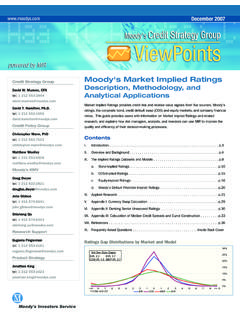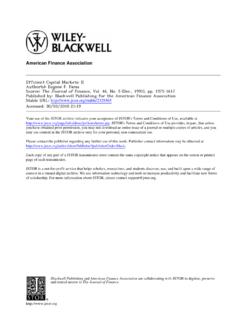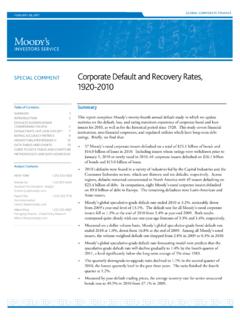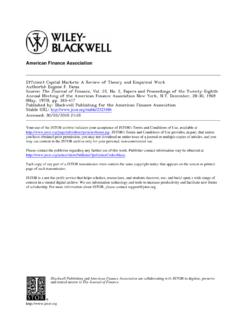Transcription of The CAPM: Theory and Evidence - efinance.org.cn
1 Amos Tuck School of Business at dartmouth college Working Paper No. 03-26 Center for Research in Security Prices (CRSP) University of Chicago Working Paper No. 550 the capm : Theory and Evidence Eugene F. Fama University of Chicago Kenneth R. French dartmouth college ; MIT; NBER August 2003 This paper can be downloaded without charge from the Social Science Research Network Electronic Paper Collection at: First draft: August 2003 Not for quotation Comments solicited the capm : Theory and Evidence by Eugene F. Fama and Kenneth R. French* The capital asset pricing model (CAPM) of William Sharpe (1964) and John Lintner (1965) marks the birth of asset pricing Theory (resulting in a Nobel Prize for Sharpe in 1990).
2 Before their breakthrough, there were no asset pricing models built from first principles about the nature of tastes and investment opportunities and with clear testable predictions about risk and return. Four decades later, the capm is still widely used in applications, such as estimating the cost of equity capital for firms and evaluating the performance of managed portfolios. And it is the centerpiece, indeed often the only asset pricing model taught in MBA level investment courses. The attraction of the capm is its powerfully simple logic and intuitively pleasing predictions about how to measure risk and about the relation between expected return and risk. Unfortunately, perhaps because of its simplicity, the empirical record of the model is poor poor enough to invalidate the way it is used in applications.
3 The model s empirical problems may reflect true failings. (It is, after all, just a model.) But they may also be due to shortcomings of the empirical tests, most notably, poor proxies for the market portfolio of invested wealth, which plays a central role in the model s predictions. We argue, however, that if the market proxy problem invalidates tests of the model, it also invalidates most applications, which typically borrow the market proxies used in empirical tests. For perspective on the capm s predictions about risk and expected return, we begin with a brief summary of its logic. We then review the history of empirical work on the model and what it says about shortcomings of the capm that pose challenges to be explained by more complicated models.
4 * Graduate School of Business, University of Chicago (Fama), and Tuck School of Business, dartmouth college (French). 2 I. the capm the capm builds on Harry Markowitz (1952, 1959) mean-variance portfolio model. In Markowitz model, an investor selects a portfolio at time t-1 that produces a random return Rpt at t. The model assumes that investors are risk averse and, when choosing among portfolios, they care only about the mean and variance of their one-period investment return. The model s main result follows from these assumptions. Specifically, the portfolios relevant for choice by investors are mean-variance efficient, which means (i) they minimize portfolio return variance, s2(Rpt), given expected return, E(Rpt), and (ii) they maximize expected return given variance.
5 The way assets combine to produce efficient portfolios provides the template for the relation between expected return and risk in the capm . Suppose there are N risky assets available to investors. It is easy to show that the portfolio e that minimizes return variance, subject to delivering expected return E(Re), allocates proportions of invested wealth, xie 1( )Niiex== , to portfolio assets so as to produce a linear relation between the expected return on any asset i and its beta risk in portfolio e, (1a) ()()[()()],izeezeieERERERER =+ i=1,..,N, (1b) 1211(,)(,).()(,)NjeijjieieNNeiejeijijxCo vRRCovRRRxxCovRR ===== In these equations, Cov denotes a covariance, E(Rze) is the expected return on assets whose returns are uncorrelated with the return on e (they have Cov(Ri, Re) = 0), and the subscript t that should appear on all returns is, for simplicity, dropped.
6 To interpret (1a) and (1b), note first that in the portfolio model, expected returns on assets and covariances between asset returns are parameters supplied by the investor. Equations (1a) and (1b) then say that given these inputs, finding the portfolio that minimizes return variance subject to having expected return E(Re) implies choosing asset weights (xie, i=1,..,N) that produce beta risks ( ie, i=1,..,N) that cause (1a) to be satisfied for each asset. 3 The beta risk of asset i has an intuitive interpretation. In Markowitz model, a portfolio s risk is the variance of its return, so the risk of portfolio e is s2(Re). The portfolio return variance is the sum of the weighted covariances of each asset s return with the portfolio return, (2) 2()(,).
7 EieieRxCovRR = Thus, ie = Cov(Ri, Re)/s2(Re) can be interpreted as the covariance risk of asset i in portfolio e, measured relative to the risk of the portfolio, which is just an average of the covariance risks of all assets. Equation (1a) is the result of algebra, the condition on asset weights that produces the minimum variance portfolio with expected return equal to E(Re). the capm turns it into a restriction on market clearing prices and expected returns by identifying a portfolio that must be efficient if asset prices are to clear the market of all securities. Applied to such a portfolio, equation (1a) becomes a relation between expected return and risk that must hold in a market equilibrium. Sharpe and Lintner add two key assumptions to the Markowitz model to identify a portfolio that must be efficient if the market is to clear.
8 The first is complete agreement: Given market clearing prices at t-1, investors agree on the joint distribution of asset returns from t-1 to t. And it is the true distribution, that is, the distribution from which the returns we use to test the model are drawn. The second assumption is that there is borrowing and lending at a riskfree rate, Rf, which is the same for all investors and does not depend on the amount borrowed or lent. Such unrestricted riskfree borrowing and lending implies a strong form of Tobin s (1958) separation theorem. Figure 1, which describes portfolio opportunities in the (E(R), s(R)) plane, tells the story. The curve abc traces combinations of E(R) and s(R) for portfolios that minimize return variance at different levels of expected return, but ignoring riskfree borrowing and lending.
9 In this restricted set, only portfolios above b along abc are efficient (they also maximize expected return, given their return variances). Adding riskfree borrowing and lending simplifies the efficient set. Consider a portfolio that invests the proportion x of portfolio funds in a riskfree security and 1-x in some portfolio g, (3a) Rp = xRf + (1-x)Rg, x = 4 The expected return and the standard deviation of the return on p are, (3b) E(Rp) = xRf + (1-x)E(Rg), (3c) s(Rp) = |1-x| s(Rg). These equations imply that the portfolios obtained by varying x in (3a) plot along a straight line in Figure 1. The line starts at Rf (x = , all funds are invested in the riskfree asset), runs to the point g (x = , all funds are invested in g) and continues on for portfolios that involve borrowing at the riskfree rate (x < , with the proceeds from the borrowing used to increase the investment in g).
10 It is then easy to see that to obtain the efficient portfolios available with riskfree borrowing and lending, one simply swings a line from Rf in Figure 1 up and to the left, to the tangency portfolio T, which is as far as one can go without passing into infeasible territory. The key result is that with unrestricted riskfree borrowing and lending, all efficient portfolios are combinations of the single risky tangency portfolio T with either lending at the riskfree rate (points below T along the line from Rf) or riskfree borrowing (points above T along the line from Rf). This is Tobin s (1958) separation theorem. the capm s punch line is now straightforward. With complete agreement about distributions of returns, all investors combine the same tangency portfolio T with riskfree borrowing or lending.









